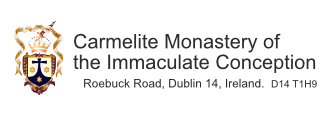“All of us who wear this holy Carmelite habit are called to prayer and contemplation. This is what we were founded for. We are descended from those holy fathers of ours on Mount Carmel, those who went in search of that treasure – the priceless pearl we are talking about – in such solitude and with such contempt for the world” – St. Teresa of Jesus
St Teresa of Avila, 1515 - 1582
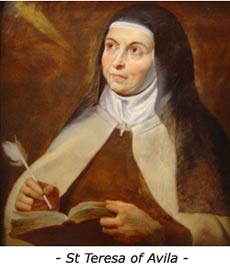 The Carmelite Monastery of the Incarnation, Avila, was home to some 150 nuns when it opened its door to receive the twenty year-old Teresa. Happiness became her lot despite sickness and an inner struggle lasting twenty years. Loving and lovable by nature, Teresa’s capacity for friendship received a new impetus when she realisd twenty years later that Christ himself was her true friend. This relationship was the foundation of her prayer. Friendship demands intimacy – a small group of praying women, devoted to Christ and his mother Mary, living simply as sisters and in friendship; a modest secluded property but hearts open to the concerns of Christ – this was the vision of Teresa and her friends. St Joseph’s, Avila is that reality still today and in over 800 other locations worldwide.
The Carmelite Monastery of the Incarnation, Avila, was home to some 150 nuns when it opened its door to receive the twenty year-old Teresa. Happiness became her lot despite sickness and an inner struggle lasting twenty years. Loving and lovable by nature, Teresa’s capacity for friendship received a new impetus when she realisd twenty years later that Christ himself was her true friend. This relationship was the foundation of her prayer. Friendship demands intimacy – a small group of praying women, devoted to Christ and his mother Mary, living simply as sisters and in friendship; a modest secluded property but hearts open to the concerns of Christ – this was the vision of Teresa and her friends. St Joseph’s, Avila is that reality still today and in over 800 other locations worldwide.
Teresa died in Alba de Tormes in 1582. Canonized in 1622, she became in 1970, together with Catherine of Siena, one of the first two women Doctors of the Church in recognition of the wisdom of her life and her teachings. Her autobiography and letters are widely available. The Way of Perfection and the Interior Castle contain much on prayer.
John of the Cross, 1542 – 1591
 John de Yepes, the youngest sibling of three boys, was born in Castile in Spain. The untimely death of his weaver father left the family destitute. Infant mortality claimed a brother. His mother, Catalina, in search of a livelihood, took Francisco and Juan to Medina del Campo. His schooling was with the Jesuits at night. Artistic and sensitive he spent his days caring for the sick and dying in a local hospital. He joined the Carmelite friars when twenty-one.
John de Yepes, the youngest sibling of three boys, was born in Castile in Spain. The untimely death of his weaver father left the family destitute. Infant mortality claimed a brother. His mother, Catalina, in search of a livelihood, took Francisco and Juan to Medina del Campo. His schooling was with the Jesuits at night. Artistic and sensitive he spent his days caring for the sick and dying in a local hospital. He joined the Carmelite friars when twenty-one.
Teresa and John met for the first time in 1567. He wanted a more solitary life. She had the solution: he could find all he desired, still within the Carmelite ranks. Was he prepared to be one of the initiators of a new thrust in our Lady’s Order? The challenge was accepted on the condition that he did not have to wait long.
Numbers grew but there were many problems both practical and personal. It was during times of intense physical suffering and inner anguish that John, wrote some of the most outstanding poetry ever to spring from a heart given to God. Small in stature, weak in body and yet alive in Christ, John died while staying at the Ubeda friary in 1591.
Canonized in 1726, he was declared a Doctor of the Church in 1926. His writings, poetry and prose, include, The Ascent of Mount Carmel; Dark Night and the Living Flame of Love. All are in print.
Therese of Lisieux, 1873 – 1897
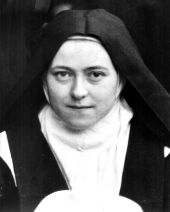 The youngest of a large French family Therese Martin was born in Alencon in 1873. Her father, Louis, quiet and reflective was a watchmaker and complemented his dynamic lace making wife, Zelie who ran her own business. There was another side to this woman. She said of herself that she was ‘born to have children’ and her five surviving daughters all witnessed to her love for them. Breast cancer claimed Zelie when Therese was four. The family moved to Lisieux.
The youngest of a large French family Therese Martin was born in Alencon in 1873. Her father, Louis, quiet and reflective was a watchmaker and complemented his dynamic lace making wife, Zelie who ran her own business. There was another side to this woman. She said of herself that she was ‘born to have children’ and her five surviving daughters all witnessed to her love for them. Breast cancer claimed Zelie when Therese was four. The family moved to Lisieux.
The home, Les Buissonets, was deeply religious. Louis had wanted to be a monk; Zelie, a Daughter of Charity. All the girls would eventually become nuns. This did not prevent there being much laughter and happiness despite the absence of Zelie but Therese was deeply affected by her loss. Her outgoing nature suffered a severe reversal and it was only in her own home that she could feel herself. The two eldest girls joined the Carmelites in Lisieux; Therese herself was among them by the age of fifteen. This was not, she said, to be with her sisters but to give herself to Jesus and, in the phraseology of the time, to ‘save souls’ by prayer and self-gift. A fourth sister joined after Therese and finally a cousin.
Nine years saw the transition from teenager to a young woman struggling with her beloved father’s mental and physical deterioration and the demands of community life. There were temptations to unbelief as her young body, in common with so many of that era, fought against tuberculosis. These were also years of intense growth as Therese discovered a way forward, a direct way, to God – by love and confidence in him. For Zelie’s daughter had inherited her mother’s inner drive and brought all her resources to the service of God and his people. Death – it came on 30 September 1897 – would not mean endless inactivity – she said she would return to do good on earth. This, for her, was heaven.
Canonized in 1925, Therese’s feast is celebrated on 1st October each year. She became the third Carmelite Doctor of the Church in 1997. This Patroness of the Missions describes her thoughts on the mercy of God in the book known to us as the Story of a Soul.
Elisabeth of the Trinity, 1880 – 1906
 Another Frenchwoman, Elisabeth Catez was born at Bourges in 1880. This daughter of an army officer early displayed her headstrong and lively temperament. This was in sharp contrast to the gentleness of her only sister Margueite (Guite). The sight of military displays was a source of delight and fed Elisabeth’s love of excitement.
Another Frenchwoman, Elisabeth Catez was born at Bourges in 1880. This daughter of an army officer early displayed her headstrong and lively temperament. This was in sharp contrast to the gentleness of her only sister Margueite (Guite). The sight of military displays was a source of delight and fed Elisabeth’s love of excitement.
Elisabeth showed considerable musical talent while young and, combined with her liking for fashion, she became a favourite among her peers. Underneath all this there was another desire – Elisabeth was determined to give her whole self to God as a Carmelite. In 1901 when she was twenty-one, she left her nearby home for the monastery in Dijon. She found, through deep and persevering prayer, all that she longed for within her: heaven on earth. She loved God and she loved the nuns of the community. She knew herself to be loved by them.
Her name, Elisabeth, meaning the house of God, gradually unfolded its mystery. The traditional dedication added to a Carmelite’s name, in her case ‘of the Trinity’, conversely drew her into itself throughout her five years as a Carmelite. The cause of her failing health was diagnosed as Addison’s Disease (then incurable) and she struggled to face death as a follower of Jesus. She was able, in her faith, to say, ‘I am going to light, to love, to life . . .’
Pope John Paul II declared her Blessed in 1984. Her mission, she felt, was a hidden one – to draw people to God by a simple movement, one full of love. Elisabeth never wrote a book. Jottings and notes have been collected and published and are available in many languages.
Teresa of the Andes, 1900 – 1920
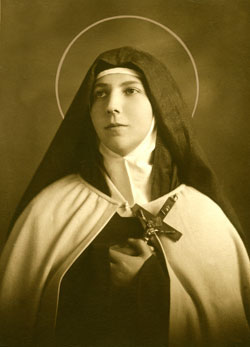 Juanita Fernandez Solar was born in Santiago, Chile in 1900. The fourth of six children she was lively, lovable and attractive. Swimming, sport and riding were favourite pastimes but did not prevent her giving time to prayer and helping with the care of the poor in the locality. The writings of the Carmelite nuns Therese of Lisieux and Elisabeth of Dijon affected her deeply. Responding to what she felt was her way forward in life she chose to undertake the lifestyle that had been theirs.
Juanita Fernandez Solar was born in Santiago, Chile in 1900. The fourth of six children she was lively, lovable and attractive. Swimming, sport and riding were favourite pastimes but did not prevent her giving time to prayer and helping with the care of the poor in the locality. The writings of the Carmelite nuns Therese of Lisieux and Elisabeth of Dijon affected her deeply. Responding to what she felt was her way forward in life she chose to undertake the lifestyle that had been theirs.
Juanita changed her name to Teresa when she joined the Carmelites in their poor monastery at the foot of the Andes. Joy was the keynote of her life. She contracted typhus and died just three months before her twentieth birthday. Large numbers of young people attended her funeral Mass. Teresa’s attraction for young people has not lessened over the years and large numbers from all over Chile and further continue to pray at the place that was her home. Her sister Rebecca joined the community too. Teresa was the first canonized saint of Chile
Edith Stein, 1891 – 1942
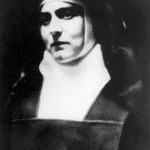 Born on the Jewish Day of Atonement in 1891 in Breslau, Germany, Edith Stein was two years old when her father died of sunstroke. His wife was immediately responsible for the upbringing of seven children and the management of a timber business.
Born on the Jewish Day of Atonement in 1891 in Breslau, Germany, Edith Stein was two years old when her father died of sunstroke. His wife was immediately responsible for the upbringing of seven children and the management of a timber business.
Edith’s intelligence was exceptional and she eventually gained a Ph.D. She became a research assistant to Edmund Husserl, the ‘father’ of phenomenology. She was an outstanding educator and travelled widely in Europe in addition to making radio broadcasts and lecturing. Philosophy and the search for truth were her constant preoccupation. Reading, by chance, the Life of Teresa of Avila introduced her quite unexpectedly to Truth himself, Jesus Christ, and to the possibility of a personal relationship with God that she had felt unable to achieve through her Jewish faith. She had consciously chosen not to pray as a teenager and now, as an adult, she was confronted by the very Person of Christ.
Edith was baptized in 1922 and during some of the ensuing years eleven years she was greatly helped by the Benedictine Abbot of Bueron. In 1933 she joined the Carmelite community in Cologne. Her new name was Teresa Benedicta of the Cross. This cross of Christ was soon to be laid on her shoulder and that of her sister Rosa. Edith’s intellectual work continued during part of her Carmelite life and she was working on The Science of the Cross when, one day just after the start of the evening’s hour of silent prayer, she was taken from the monastery in Echt, Holland where the two sisters had taken refuge. Edith was taken from the nun’s part of the chapel and Rosa, was taken too – they were going as she said to the greatly distressed Rosa, ‘for our people’.
It was a matter of mere days before the two were gassed in August 1942 but not before Edith had left an exceptional impression of light and radiance in that dark place of pain and horror. They were two middle-aged women among unknown millions of every age and condition. God has brought them into a representational place of light. Pope John Paul II canonized Edith in 1998. In April 2000 Edith Stein was declared co-patroness of Europe with St. Bridget of Sweden and St. Catherine of Sienna.
Edith’s writings include an autobiographical work covering a substantial part of her life as a lay person, Life in a Jewish Family. Other papers and some letters have been published by the Institute of Carmelite Studies, Washington.
